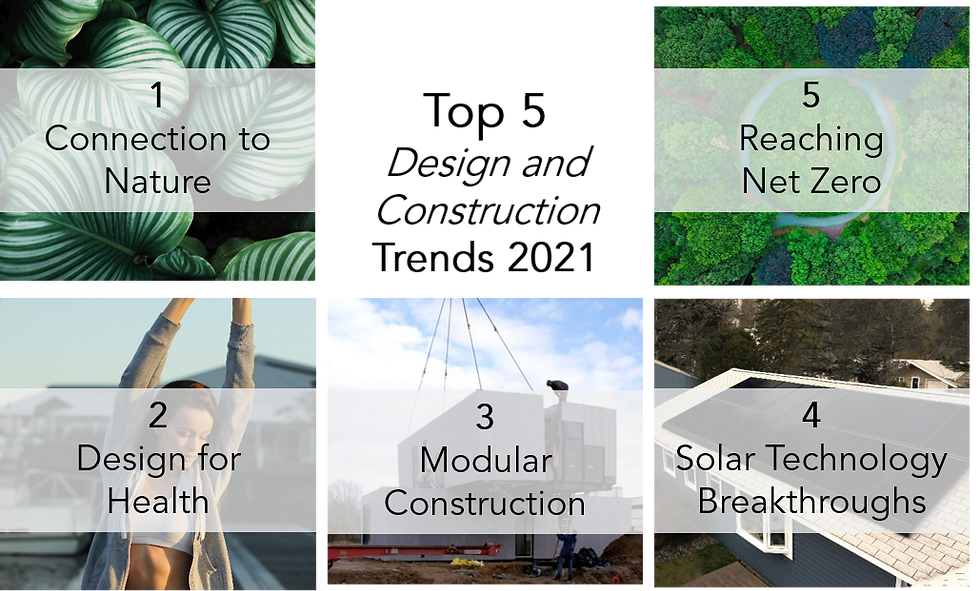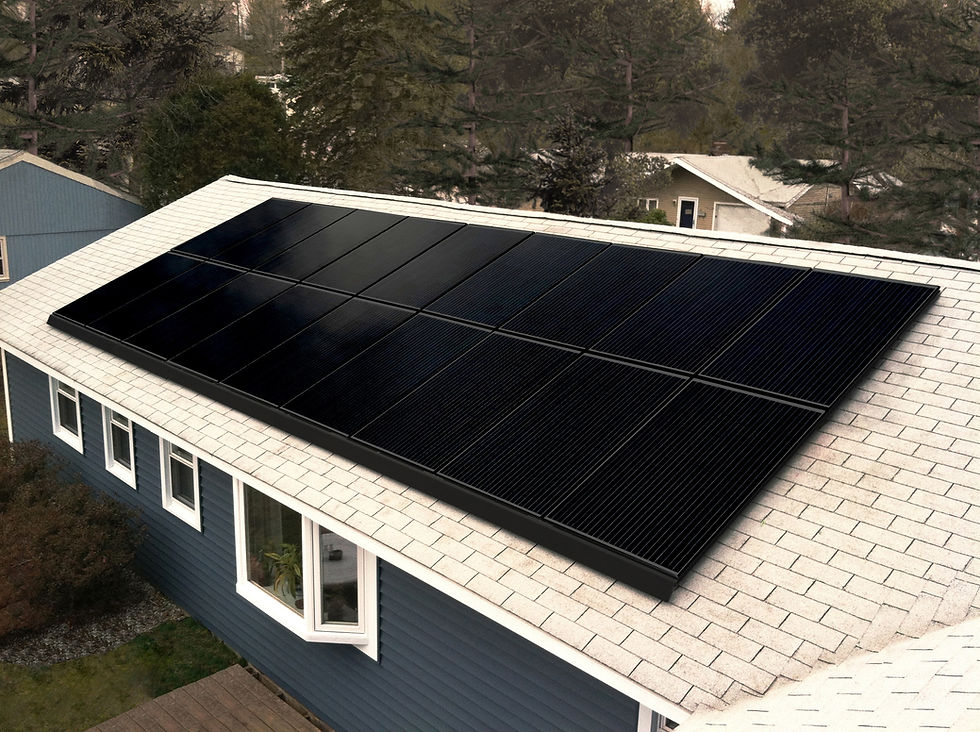Top 5 Trends in Design & Construction for 2021
- Armelle Le Bihan
- Feb 9, 2021
- 5 min read
Updated: Feb 11, 2021
2021 has been kicking off for a month already and with it design projects take shape. In a race to mitigate the consequences of climate change, yet supply a growing population with building needs, we look ahead at which trends are gaining momentum in 2021 and how they could shape the future of our living environments and cities. Here is our take on 2021's top 5 trends in design and construction.

1. Connection to Nature

The link between nature and our physical and mental wellbeing has long been recognized by the medical and science community.
But with lockdowns forcing us to stay indoors in relatively small spaces, our longing for open spaces, nature and calm has grown into each and everyone of us. For those living in urban environments, this has maybe even been something that was lingering pre-pandemic with most cities offering little place to live, work and play within green environments. The fact being that more of us are expressing a desire to be closer to nature, even live further from urban centers which WFH is making now possible. From gardens, to proximity to parks or even more rural settings, young and less young families and couples are exoding to places with greater spaces and nature.
"66% of respondents say large gardens and outdoor space are more important, with the lockdown period having emphasised the connection between wellbeing and the great outdoors" according to a post-covid Knight Franck study.
Even within interiors, we’ve seen an uptake in the purchase of plants. Plants benefit us in multiple ways, they can soothe us and heal us. An overwhelming evidence has shown the correlation between nature and our health and wellbeing. The concept is called biophilia and grew from the idea that we are naturally drawn to nature by our very nature itself. After all, this is where we all come from.
A study published in Frontier in Psychology, the largest peer-reviewed research journal in its field, exploring the Benefits of a Green Building’s Indoor Environment on Wellbeing suggests that
“people who live in built environments with more nature suffer from fewer cardiovascular and respiratory diseases, have enhanced immune function, have lower odds of experiencing serious psychological conditions such as anxiety and depression, are less likely to require antidepressants, recover faster from illness, and live longer.”
2. Design for Health, Wellness, and Indoor Air Quality

As Covid-19 has strengthened our desire to connect to nature, not surprisingly, it has also intensified the importance of health, especially when it comes to indoor air quality. Indoor air quality has long been a fundamental pillar of Indoor Environmental Quality (IEQ) and green building standards.
But the current pandemic has put a direct and contemporary link between air quality and health risks. Indeed, we’ve seen many superspreader events happening in closed indoor environments. This does not give a super reputation to buildings. A lot of discussions have been questioning ventilation levels, air filtration but also water flows and materials.
Over the past decades, as more people became aware of building related illnesses and indoor pollutants sources, developers have been adjusting to this growing demand. Air purifiers, non toxic paints, air-cleaning plants, high efficiency filters but also increased ventilation rates are some of the strategies which have been employed in newly built facilities as well as retrofits and that we believe will continue to be required both by users and stricter building regulations.
More than just poor health prevention, a growing body of evidence has shown that design choices could induce indoor environments which would positively affect our physical and mental states. A recent study in the US found that employees of green buildings demonstrated
“26.4% higher cognitive function scores, 30% fewer sick-building symptoms, and 6.4% higher sleep quality scores than employees in conventional buildings”
3. Modular and Prefabricated Construction

What used to be a strategy for cheaper projects is graduating to be the ultimate win win win solution to cut on costs, stay on schedule and deliver more sustainable projects.
The modular construction market is projected to reach $157 billion by 2023 and is showing no sign of slowing down.
One of the most recently mediatized examples of such a construction are the two major hospitals in Wuhan which were built in only 10 days in a needed quick response to the Covid-19 outbreak.
Modular construction is the process of building using modules which are manufactured in a factory and assembled partially or entirely on site. Modules can be a room, a house or even a whole floor. Particularly for large multi unit projects, this strategy allows to replicate structures and therefore save time. Modular construction can reduce construction time by as much as 50% reports a study by McKinsey & Company .
In terms of sustainability, modular and prefabricated buildings support the green building approach as they take on a systemic approach to development being thought through the entire building’s life, from early planning to design, manufacturing, logistics, assembly, operation, maintenance and even end of life.
All in all, modular construction helps projects to be completed faster, save on costs, have a smaller carbon footprint and generate less material waste.
4. Breakthrough Solar Technologies

Have you heard about solar fabric?
This emerging PV technology is cost competitive, non toxic, has a longer lifespan than its solar counterparts and has already reached low payback periods.
The perovskite-based PV cells have a high semiconducting capacity and therefore yield good efficiencies even in more overcast skies. Developments are pushing the efficiencies further to place it as a technology of choice and have managed so far to reach power conversion efficiency exceeding 20%. But what really differentiates this solar material from traditional silicon based cells is that it is lightweight, easy to manufacture and extremely flexible. This versatility allows it to be “printed” on almost any objects or “woven” into any type of materials. Think canopies, complex roof structures and building facades.
But furthermore, applications could go beyond the built environment alone and be applied to textiles. Researchers are embedding solar fabric into clothes with the ambition of having them both keep us warm and generate energy for immediate use such as recharging a cell phone on the go.
This is one of the many breakthroughs happening in the renewable and solar field. But it doesn't stop there. Building-integrated PV (BIPV) have reached higher grounds as well as transparent solar modules. In the shape of a roof tile or a facade glass, BIPVs make it possible to generate energy through buildings all while respecting the architectural spirit. Researchers have even come up with transparent solar cells which would in the future allow structures to generate solar even through clear glass windows.
5. Reaching Net Zero Targets

Last but not least, the industry is revisiting it’s targets and setting net zero as a standard. Beyond energy efficiency or low carbon strategies, net zero refers to the concept of achieving an overall balance in regards to its input and output. A building can be net zero carbon, net zero energy, net zero water or all three of them at the same time. If you take energy, net zero energy would mean a building produces as much energy as it consumes.
The World Green Building Council has launched a project, Advancing Net Zero to develop a framework towards the sector’s decarbonisation by 2050.
“The global net zero energy buildings market share was valued at $896.6 million in 2018 and is expected to reach $2,106.6 million by 2024, advancing at a CAGR of 15.6% during the forecast period (2019–2024)” according to a market research report published by P&S Intelligence.
The global net zero movement seems to have taken up speed, notably because developers (especially commercial) are recognizing the fact that it is feasible but also because there is a growing concern for businesses to be accountable and transparent. Carbon neutrality and beyond demonstrates that commitment in addition to the one of serving public good and driving climate action.
#reconnectnature #biophilia #solar #tech4good #health #wellness #airquality #modularconstruction #sustainability #carbonneutral #towardsnetzero #greenbuildingsasia #top5 #trends









Comments